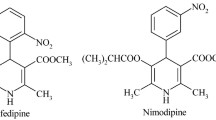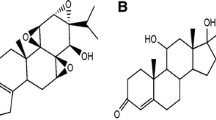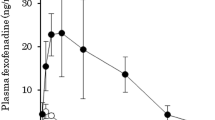Abstract
Purpose
The oral bioavailability of some therapeutic agents is markedly lower in cynomolgus monkeys than in humans. We investigated small-intestinal absorption of the P-glycoprotein (P-gp) substrates etoposide and digoxin in monkeys to clarify the influence of efflux transport on their intestinal permeability.
Methods
The pharmacokinetics of etoposide and digoxin was examined in monkeys and rats after oral and intravenous administration. Intestinal permeability and segmental differences in permeability were investigated with an Ussing-type chamber.
Results
The bioavailability of etoposide was 12.9 and 13.9% in monkeys and rats, respectively. Total body clearance of etoposide in monkeys was much less than hepatic blood flow, suggesting that the bioavailability would be limited at intestinal absorption. Marked vectorial transport of etoposide in the secretory direction was observed in rats, especially in the lower small intestine, and segmental differences were consistent with the distribution of P-gp expression. Vectorial transport was minimal in monkey small intestine. Our kinetic analysis indicated that P-gp contributes little to the intestinal permeability of etoposide and digoxin in monkeys, and apical uptake is rate-limiting.
Conclusion
Low bioavailability of etoposide in monkeys is due to poor intestinal uptake resulting from low influx from the apical side, rather than secretion via P-gp.




Similar content being viewed by others
References
K. W. Ward, R. Nagilla, and L. J. Jolivette. Comparative evaluation of oral systemic exposure of 56 xenobiotics in rat, dog, monkey and human. Xenobiotica. 35:191–210 (2005).
W. L. Chiou, and P. W. Buehler. Comparison of oral absorption and bioavailablity of drugs between monkey and human. Pharm Res. 19:868–74 (2002).
W. K. Sietsema. The absolute oral bioavailability of selected drugs. Int J Clin Pharmacol Ther Toxicol. 27:179–211 (1989).
T. Nishimura, N. Amano, Y. Kubo, M. Ono, Y. Kato, H. Fujita, Y. Kimura, and A. Tsuji. Asymmetric intestinal first-pass metabolism causes minimal oral bioavailability of midazolam in cynomolgus monkey. Drug Metab Dispos. 35:1275–1284 (2007).
P. B. Watkins. The barrier function of CYP3A4 and P-glycoprotein in the small bowel. Adv Drug Deliv Rev. 27:161–170 (1997).
L. Z. Benet, C. L. Cummins, and C. Y. Wu. Unmasking the dynamic interplay between efflux transporters and metabolic enzymes. Int J Pharm. 277:3–9 (2004).
M. Maliepaard, G. L. Scheffer, I. F. Faneyte, M. A. van Gastelen, A. C. Pijnenborg, A. H. Schinkel, M. J. van De Vijver, R. J. Scheper, and J. H. Schellens. Subcellular localization and distribution of the breast cancer resistance protein transporter in normal human tissues. Cancer Res. 61:3458–3464 (2001).
A. D. Mottino, T. Hoffman, L. Jennes, and M. Vore. Expression and localization of multidrug resistant protein mrp2 in rat small intestine. J Pharmacol Exp Ther. 293:717–723 (2000).
M. F. Fromm, H. M. Kauffmann, P. Fritz, O. Burk, H. K. Kroemer, R. W. Warzok, M. Eichelbaum, W. Siegmund, and D. Schrenk. The effect of rifampin treatment on intestinal expression of human MRP transporters. Am J Pathol. 157:1575–1580 (2000).
Q. Wang, R. K. Bhardwaj, D. Herrera-Ruiz, N. N. Hanna, I. T. Hanna, O. S. Gudmundsson, T. Buranachokpaisan, I. J. Hidalgo, and G. T. Knipp. Expression of multiple drug resistance conferring proteins in normal Chinese and Caucasian small and large intestinal tissue samples. Mol Pharm. 1:447–454 (2004).
T. Terao, E. Hisanaga, Y. Sai, I. Tamai, and A. Tsuji. Active secretion of drugs from the small intestinal epithelium in rats by P-glycoprotein functioning as an absorption barrier. J Pharm Pharmacol. 48:1083–1089 (1996).
M. Takano, R. Yumoto, and T. Murakami. Expression and function of efflux drug transporters in the intestine. Pharmacol Ther. 109:137–61 (2006).
J. D. Allen, S. C. Van Dort, M. Buitelaar, O. van Tellingen, and A. H. Schinkel. Mouse breast cancer resistance protein (Bcrp1/Abcg2) mediates etoposide resistance and transport, but etoposide oral availability is limited primarily by P-glycoprotein. Cancer Res. 63:1339–1344 (2003).
V. D. Makhey, A. Guo, D. A. Norris, P. Hu, J. Yan, and P. J. Sinko. Characterization of the regional intestinal kinetics of drug efflux in rat and human intestine and in Caco-2 cells. Pharm Res. 15:1160–1167 (1998).
J. G. Hardman, and L. E. Limbird. Goodman & Gilman's: The Pharmacological Basis of Therapeutics. McGraw-Hill, New York, (2001).
B. Davies, and T. Morris. Physiological parameters in laboratory animals and humans. Pharm Res. 10:1093–1095 (1993).
J. C. Shah, J. R. Chen, and D. Chow. Oral bioavailability and in situ absorption of etoposide in rat. Int J Pharm. 84:223–32 (1992).
R. Tian, N. Koyabu, H. Takanaga, H. Matsuo, H. Ohtani, and Y. Sawada. Effects of grapefruit juice and orange juice on the intestinal efflux of P-glycoprotein substrates. Pharm Res. 19:802–809 (2002).
A. V. Kamath, R. A. Morrison, T. W. Harper, S. J. Lan, A. M. Marino, and S. Chong. Multiple pathways are involved in the oral absorption of BMS-262084, a tryptase inhibitor, in rats: role of paracellular transport, binding to trypsin, and P-glycoprotein efflux. J Pharm Sci. 94:1115–1123 (2005).
R. H. Stephens, J. Tanianis-Hughes, N. B. Higgs, M. Humphrey, and G. Warhurst. Region-dependent modulation of intestinal permeability by drug efflux transporters: in vitro studies in mdr1a(-/-) mouse intestine. J Pharmacol Exp Ther. 303:1095–1101 (2002).
M. D. Troutman, and D. R. Thakker. Efflux ratio cannot assess P-glycoprotein-mediated attenuation of absorptive transport: asymmetric effect of P-glycoprotein on absorptive and secretory transport across Caco-2 cell monolayers. Pharm Res. 20:1200–1209 (2003).
V. J. Harvey, M. L. Slevin, S. P. Joel, A. Johnston, and P. F. Wrigley. The effect of dose on the bioavailability of oral etoposide. Cancer Chemother Pharmacol. 16:178–181 (1986).
S. Reif, M. C. Nicolson, D. Bisset, M. Reid, C. Kloft, U. Jaehde, and H. L. McLeod. Effect of grapefruit juice intake on etoposide bioavailability. Eur J Clin Pharmacol. 58:491–494 (2002).
K. R. Hande, M. G. Krozely, F. A. Greco, J. D. Hainsworth, and D. H. Johnson. Bioavailability of low-dose oral etoposide. J Clin Oncol. 11:374–377 (1993).
D. E. Clark. Rapid calculation of polar molecular surface area and its application to the prediction of transport phenomena. 1. Prediction of intestinal absorption. J Pharm Sci. 88:807–814 (1999).
C. A. Lipinski, F. Lombardo, B. W. Dominy, and P. J. Feeney. Experimental and computational approaches to estimate solubility and permeability in drug discovery and development settings. Adv Drug Deliv Rev. 46:3–26 (2001).
H. M. Yao, and W. L. Chiou. The complexity of intestinal absorption and exsorption of digoxin in rats. Int J Pharm (2006).
B. Noe, B. Hagenbuch, B. Stieger, and P. J. Meier. Isolation of a multispecific organic anion and cardiac glycoside transporter from rat brain. Proc Natl Acad Sci U S A. 94:10346–10350 (1997).
X. Cheng, J. Maher, C. Chen, and C. D. Klaassen. Tissue distribution and ontogeny of mouse organic anion transporting polypeptides (Oatps). Drug Metab Dispos. 33:1062–1073 (2005).
G. A. Kullak-Ublick, M. G. Ismair, B. Stieger, L. Landmann, R. Huber, F. Pizzagalli, K. Fattinger, P. J. Meier, and B. Hagenbuch. Organic anion-transporting polypeptide B (OATP-B) and its functional comparison with three other OATPs of human liver. Gastroenterology. 120:525–533 (2001).
Y. Su, X. Zhang, and P. J. Sinko. Human organic anion-transporting polypeptide OATP-A (SLC21A3) acts in concert with P-glycoprotein and multidrug resistance protein 2 in the vectorial transport of Saquinavir in Hep G2 cells. Mol Pharm. 1:49–56 (2004).
R. H. Stephens, C. A. O’Neill, J. Bennett, M. Humphrey, B. Henry, M. Rowland, and G. Warhurst. Resolution of P-glycoprotein and non-P-glycoprotein effects on drug permeability using intestinal tissues from mdr1a (-/-) mice. Br J Pharmacol. 135:2038–2046 (2002).
A. Guo, W. Marinaro, P. Hu, and P. J. Sinko. Delineating the contribution of secretory transporters in the efflux of etoposide using Madin-Darby canine kidney (MDCK) cells overexpressing P-glycoprotein (Pgp), multidrug resistance-associated protein (MRP1), and canalicular multispecific organic anion transporter (cMOAT). Drug Metab Dispos. 30:457–463 (2002).
T. Takeuchi, S. Yoshitomi, T. Higuchi, K. Ikemoto, S. Niwa, T. Ebihara, M. Katoh, T. Yokoi, and S. Asahi. Establishment and characterization of the transformants stably expressing MDR1 derived from various animal species in LLC-PK(1). Pharm Res. 23:1460–1472 (2006).
N. Zelcer, T. Saeki, G. Reid, J. H. Beijnen, and P. Borst. Characterization of drug transport by the human multidrug resistance protein 3 (ABCC3). J Biol Chem. 276:46400–46407 (2001).
B. D. Stride, C. E. Grant, D. W. Loe, D. R. Hipfner, S. P. Cole, and R. G. Deeley. Pharmacological characterization of the murine and human orthologs of multidrug-resistance protein in transfected human embryonic kidney cells. Mol Pharmacol. 52:344–353 (1997).
Author information
Authors and Affiliations
Corresponding author
Rights and permissions
About this article
Cite this article
Nishimura, T., Kato, Y., Amano, N. et al. Species Difference in Intestinal Absorption Mechanism of Etoposide and Digoxin between Cynomolgus Monkey and Rat. Pharm Res 25, 2467–2476 (2008). https://doi.org/10.1007/s11095-008-9658-4
Received:
Accepted:
Published:
Issue Date:
DOI: https://doi.org/10.1007/s11095-008-9658-4




